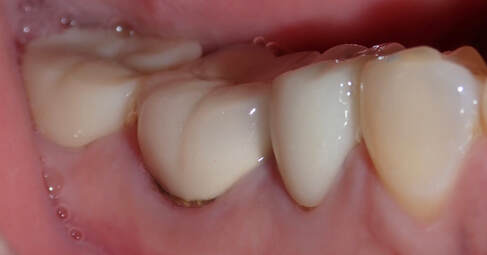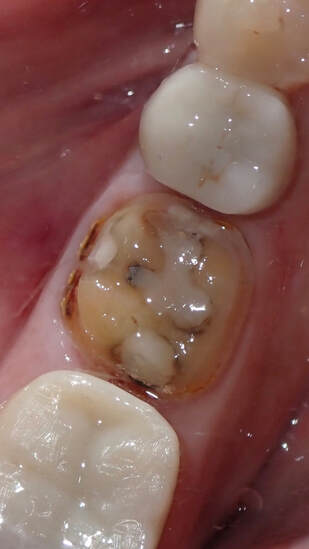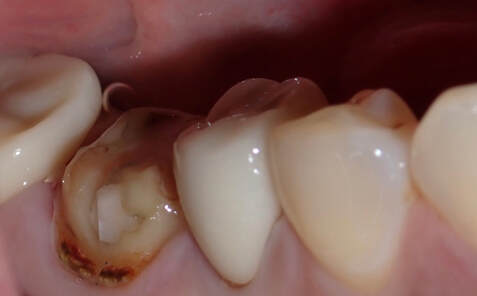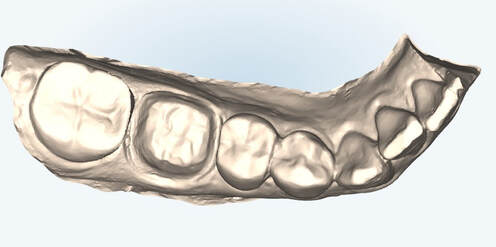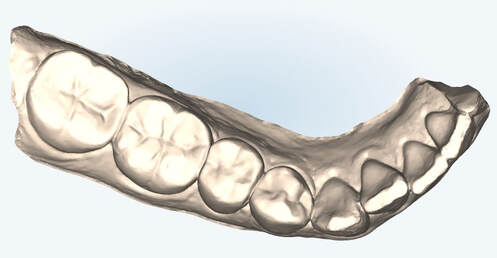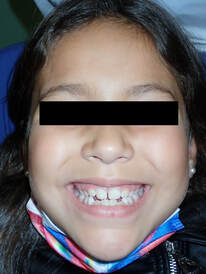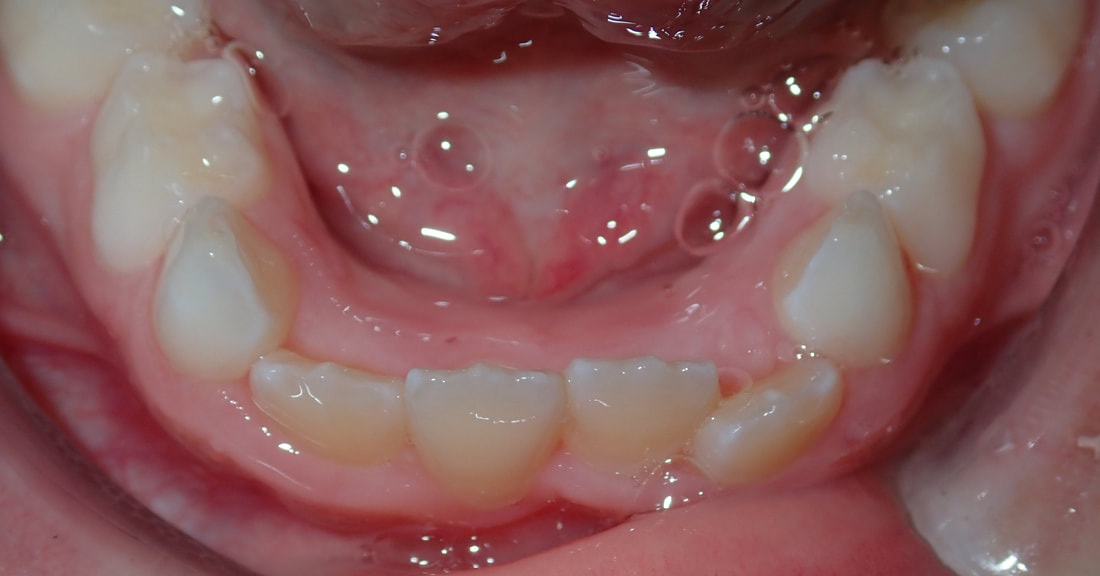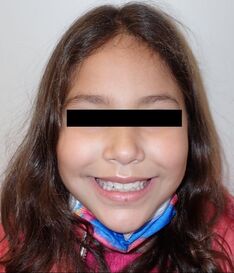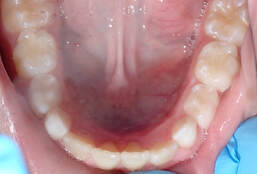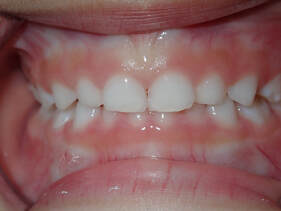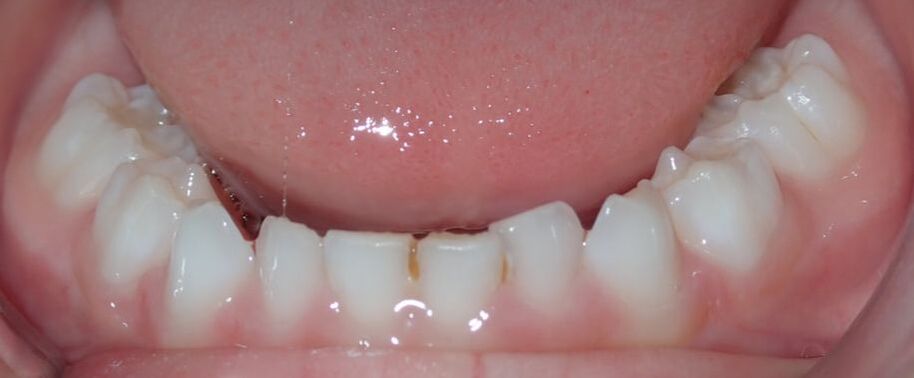|
There could be several reasons for this appearance. The first of which is the material of the crown. Many caps or crowns are made of porcelain fused to a metal base. The porcelain is designed to mimic natural teeth, however it is layered on top of metal for better strength and support. When there is gum recession, some of the metal layer can be exposed and appears as a dark line along the gum line. Another reason for the dark line could be if the tooth previously had trauma or a root canal done before getting the crown done and gum recession exposed some of the natural tooth. The natural tooth under the crown may be discolored, however this does not always indicate the presence of decay or a cavity. A clinical exam would need to be done to determine the health of the tooth structure under the crown. Lastly, the black line could be decay or a cavity. Although the cap is a false tooth to cover the natural tooth, it does not mean the natural tooth will be immune to cavities. With proper home care (brushing twice a day, flossing once a day) and regular check up visits (at least every 6 months), patients with crowns can ensure their longevity. Some patients will complain of bad breath or halitosis around their old crowns. Indeed bacteria and decay trapped under crowns needing to be replaced will cause an odorous breath. At our office, while porcelain/metal crowns are sometimes indicated, almost 99% of our crowns are made of zirconia, porcelain, or ceramic. With today’s technology, these materials can be very strong, eliminating the need for a metal base. This will also make sure you won’t get the dark metal color showing through around the gum line. With our office’s 3D scan technology (our office loves to keep up with the newest technology), when indicated, we can match a new crown to a previous tooth’s look so your retainer will still fit and your bite will feel just like your old tooth! Take a look at the pictures below to see what may be hiding under old crowns that are due to be replaced. This particular crown (porcelain fused to metal base) served our patient almost 20 years, which is about 20,000 meals! It was finally time for an upgrade to a brand new zirconia crown. Hopefully our patient can get another 20,000 meals out of the new one. After the old cap is removed, all the decay is removed, and adequately built back up with a build-up filling to fill in all the gaps where decay was. The build-up filling will also protect the nerve inside the tooth if it is alive, or protect the root canal treatment which was done. Then we do a 3D scan of the natural tooth so a brand new custom made crown can be made. Our dental lab was given instructions to match the patient's new tooth to their old tooth (to fit their retainer) using the 3D scan seen above.
The final crown restoration will be uploaded after our patient comes back in for its cementation! Our very compliant patient's results after 6 months of wearing her myofunctional appliance. Myofunctional therapy/myofunctional appliance wear is a minimally invasive, and more holistic approach to treating children with maloccolusion (misalignment of teeth like crowding or excessive spacing) in the dental office. It is used to treat patients who are mouth breathers, have a tongue thrust, thumb sucking habits, or other tongue or cheek muscle habits. These are known as incorrect myofunctional habits. A few symptoms of incorrect myofunctional habits are snoring and teeth grinding during sleep. Myofunctional therapy can be used to treat the cause of these symptoms.
A myofunctional appliance is an alternative to braces, which is less expensive, and less painful. More importantly, not only does this treatment straighten teeth, it also helps your child’s face develop to its full potential. This type of treatment is aimed to treat the cause of malocclusion and jaw development, rather than the symptoms (as traditional orthodontics do). While braces/Invisalign can straighten teeth, if the initial cause of the malocclusion is not addressed, the patient’s teeth will relapse back to their maloccclusion. The earlier a child begins treatment to address the causes of malocclusion, the better retention they will have of their straight teeth and the more successful their treatment will be. A tell tale sign of incorrect myofunctional habits is the pediatric patient with bags under their eyes. This indicates a mid-face deficiency and lack of growth. The presence of under eye bags, or venous drainage, is due to the cheek bones failing to grow forward. They instead grow down and back, leading to a "long-face" appearance. This development also acts to narrow the airway, which leads to snoring and teeth grinding. The earlier incorrect myofunctional habits are corrected, the less problems the patient will have later in life. By age 5, majority of children in the US will already show signs of malocclusion and the need for orthodontic treatment. By age 14, 90% of facial development is complete. Though orthodontics can still make the teeth look straight, it cannot significantly change the shape of the face as myofunctional therapy would. Give our office a call to see if your child would be a good candidate for myofunctional therapy. Typical appearance in snoring/grinding little patients: chipped teeth or sharp and jagged edges from grinding, crowding/tight teeth which leads to the patient being more cavity prone (as seen on the bottom front), deep bite appearance in which the top teeth almost completely cover the bottom teeth, and an under-developed lower jaw. In crowding cases like this, we can start treatment when they are as young as 4 years old. We absolutely can! Our dentists are able to perform an exam to determine if your child would be a good candidate for a myofunctional appliance. Proper appliance wear would help treat the cause of the snoring and grinding symptoms. Your child would get a good nights sleep, while also protecting their precious first set of teeth and promoting proper facial development.
Snoring and grinding are tell tale signs of sleep disordered breathing or improper nasal breathing (mouth breathing). When the patient’s airway is narrow, they will breathe predominantly through the mouth rather than through the nose. It is also a sign of poor facial development. Many children breathe through their mouths. Mouth breathing exposes the tonsils to toxins, allergens, and pollutants and can stress out the nervous system. Mouth breathing also disrupts the feedback to the upper jaw, leading to the downward, backward growth pattern seen in long-faced children with eye bags. Conversely, nasal breathing cleans, warms and humidifies the air and causes a relaxation response. Myofunctional therapy can be used to open the airway by posturing the jaw and tongue positioning. This treatment helps regulate the airway and allow adequate oxygen flow and proper growth and development of the jaws and facial structure. |
AuthorDr. Mat and Dr. Jen will occasionally post cases or pictures from our office! Archives
August 2023
Categories |
Photo from Michael Dunn~!
